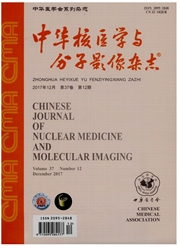

 中文摘要:
中文摘要:
目的探讨TSH抑制治疗对于绝经后DTC患者骨密度的影响。方法收集2009年9月至2014年12月上海交通大学医学院附属新华医院核医学科收治的DTC术后、绝经后患者。分别于清除甲状腺残留组织(简称清甲)、清除复发或转移灶(简称清灶)治疗前后,用双能x线骨密度仪测量腰椎骨密度(T值)。所有患者均在清甲或清灶治疗后常规口服甲状腺激素。根据TSH水平将患者分成TSH抑制组(中位TSH〈0.30mU/L)和对照组(中位TSH≥0.30mU/L)。采用Mann—Whitney1/,检验和Kruskal—Wallis检验分析数据。结果共纳入患者126例,其中TSH抑制治疗组65例[平均年龄(57.65±6.65)岁]、对照组61例[平均年龄(56.19±7.17)岁];均随访2年。TSH抑制治疗组和对照组治疗前T值分别为-1.70(-2.30,-0.55)和-1.30(-2.10,-0.30)(z=-1.660,P〉0.05)。TSH抑制组治疗前T值和随访1年及2年-2.25(-2.48,-0.83),-1.95(-2.70,-0.60)]比较,差异有统计学意义(日=6.244,P〈0.05);对照组治疗前后T值差异无统计学意义(日=1.102,P〉0.05)。随访1年和2年,aSH抑制治疗组与对照组的T值差异均有统计学意义(z值:-2.170和-2.160,均P〈0.05)。结论TSH抑制治疗是绝经后DTC患者骨量减少的危险因素,在其长期随访中应定期检测骨密度。
 英文摘要:
英文摘要:
Objective To investigate the effect of postoperative TSH suppression on bone mineral den- sity (BMD) in postmenopausal women with DTC. Methods Postmenopausal women with postoperative DTC un- derwent thyroid residual ablation or t31I treatment for metastases at Xin Hua Hospital between September 2009 and December 2014 were enrolled and followed for 2 years. They were divided into suppressive TSH group ( median TSH〈0.30 mU/L ; group 1 ) and non-suppressive group ( median TSH t〉 0.30 mU/L; group 2). Lumber 1-4 BMD levels (T scores) were measured by a dual energy X-ray absorptiometry bone densitome- ter at baseline, 1 year and 2 years after treatment. All patients had calcium and vitamin D supplementation after TSH suppression. The T scores were compared with Mann-Whitney u test and Kruskal-Wallis test. Re- suits A total of 126 patients were enrolled and followed up for 2 years, including 65 with average age (57.65±6.65) years in group 1 and 61 with average age (56.19±7.17) years in group 2. The T scores in group 1 and group 2 at baseline were -1.70(-2.30, -0.55) and -1.30(-2.10, -0.30)(z=-1.660, P〉 0. 05). The difference of T scores was significant in group 1 at baseline, 1-year follow-up and 2-year follow- up (-2.25(-2.48, -0.83), -1.95(-2.70, -0.60) ; H=6.244, P〈0.05), but not significantly different in group 2 (H= 1.102, P〉0.05). The T values were different between the 2 groups both in 1-year follow-up and 2-year follow-up (z values: -2.170, -2.160, both P〈0.05). Conclusions TSH suppression signifi- candy increases the risk of postoperative osteoporosis. The BMD should be followed up annually in postm- enopausal DTC patients.
 同期刊论文项目
同期刊论文项目
 同项目期刊论文
同项目期刊论文
 期刊信息
期刊信息
